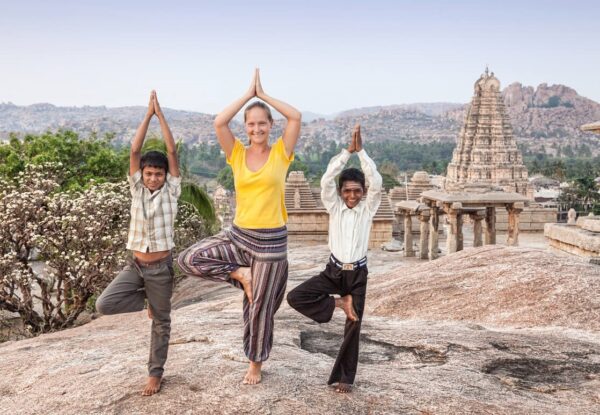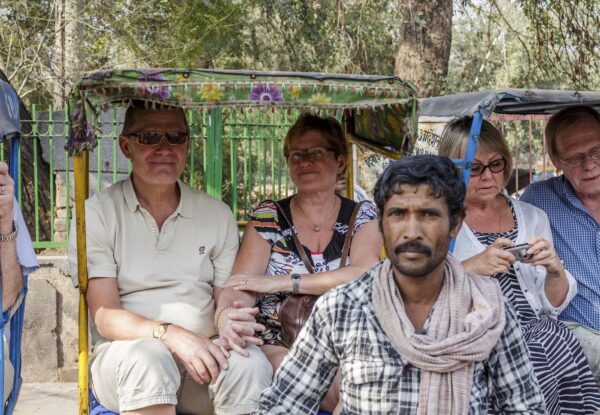Highlights of India Getaway - Delhi to Mumbai
Trip Details
- Be energized in Amritsar at the magnificent Golden Temple, Sikhism’s holiest site.
- Take a scenic train journey from New Delhi to Amritsar on the Shatabdi Express India’s high-speed train.
- Observe the reenactment of the Indian and Pakistani border guards fighting for supremacy at Attari-Wagah’s border-closing ceremony.
- Be mesmerized by Old Delhi’s narrow bazaars, and feel like you’ve been time-tunneled to the medieval age.
- Visit the spectacular Taj Mahal, impressive Agra Fort, and magnificent Fatehpur Sikri, three World Heritage Monuments in Agra.
- Be awe-struck by the opulent Forts and Palaces in Jaipur & Udaipur, including the UNESCO site of Jantar Mantar (Solar Observatory) in Jaipur.
- Experience the royal lifestyle like a Maharaja at the renovated historic and luxurious Fort Palace of Sardargarh Fort.
- Be enlightened by Udaipur’s culture, people and history from your guide.
- Experience Lake Pichola in Udaipur, with the ochre and purple ridges of the wooded Aravalli Hills on one side and the impressive city on the other.
- Be amazed at the splendor of Mumbai’s colonial-era architecture: Chhatrapati Shivaji Terminus (UNESCO), University of Mumbai, and the High Court.
- Linger in the midst of the millions of things for sale in Mumbai’s ancient bazaars.
- Look at the imposing triple-headed Shiva at Elephanta Island, a UNESCO World Heritage Site

India your way, your route, your style
• Price based on two persons in a double room
• Prices are in USD Excluding international flights
• Do you prefer to travel alone or would you like to come to India with a group of friends? We will be happy to tailor-made your tour program that meets all your wishes and needs
| Travel Period | PRICE PER PERSON | |
|---|---|---|
| Apr 1, 2024 – Mar 31, 2025 | from Price on Request (Deluxe) | INQUIRE NOW |
| Apr 1, 2024– Mar 31, 2025 | from Price on Request (Luxury) | INQUIRE NOW |
Would you like to have the trip tailored to your wishes?
Our itineraries are only examples and suggestions and can be customized individually. For example, a trip can be shortened or extended with additional destinations or monuments, the hotels can be a mix of 4 and 5 star etc. Let us know your personal wishes so that we can adapt the trip to your wishes. Connect with our travel expert for a 1:1 consultation and receive your obligation free travel proposal. Together with the travel request we will send you the hotel list so that you can get a picture of the hotels selected on the internet. We promise ✔Competent and Friendly Guides ✔Expert Drivers ✔Best Hotels ✔24/7 Support. Read more on Why Vacation India?
Get in Touch: info@vacationindia.com / +91-99274-65808 (India Calling & Whatsapp) / USA/Canada: 1 (888) 414-6804
Included in the price
- 15 Days tour New Delhi to Mumbai
- 14 nights accommodation in mentioned hotels or similar with daily breakfast.
- Surface Travel by exclusive air-conditioned MPV Toyota Innova Car
- All transfers & sightseeing as per the itinerary by air-conditioned MPV Innova Car
- Private Airport Transfers
- Guided Walk or Rikshaw Ride in Old Delhi through Old Delhi-Jama Masjid, Gurduwara (Sikh Temple), Chandni Chowk Bazaar
- First Class Train Ticket from New Delhi to Amritsar and from Amritsar to New Delhi
- Guided walk or Rikshaw Ride in Jaipur through Bazaars of old pink city
- Elephant ride (alternatively by jeeps) to ascend Amber Fort in Jaipur
- Excursion to Nahargarh (Tiger) Fort in Jaipur to watch the sunset and beautiful view of Jaipur
- Boatride on Lake Pichola in Udaipur
- Excursion to Elephanta and Kanheri caves
- Entrance fee to all monuments as per the program
- Mineral water (1 litre) per person per day during roundtrip
- An excellent English-speaking local guide shall be provided for the sightseeing tours
- Representative for assistance on all arrival and departure transfers
- All applicable taxes and service charges
- All taxes, driver allowances, parking, fuel charges, interstate taxes, tolls etc
Not included in the price
- International Flight
- Domestic Flights
- Lunch and Dinner
- Any other services not mentioned in the inclusions
- Visa & Insurance
- Expense of personal nature like tipping, laundry, telephone/fax calls, alcoholic beverages, camera/video camera fee at monuments, medical expenses, etc.
There are no reviews yet. Be the first one to write one.
To receive the list of Hotels selected for this tour, please email us at info@vacationindia.com
Keywords: India Getaway Delhi to Mumbai Tour, Getaway of India Mumbai to Delhi to Tour
Similar Tours You May Like
Top Destinations in Rajasthan Including Heritage Palace Hotels, the Taj Mahal and a Goa Beach Holiday
Old and New Delhi ➜ Jaipur ➜ Jodhpur ➜ Ranakpur ➜ Udaipur ➜ Sardargarh Heritage Palace Hotel ➜ Bundi ➜ Ranthambhore National Park ➜ Agra (Taj Mahal and Red Fort) ➜ New Delhi ➜ Fly to Goa ➜ New Delhi/ Mumbai
Best of North and South India in 28 Days
Old and New Delhi ➜ Udaipur ➜ Ranakpur ➜ Jodhpur ➜ Deogarh Palace Heritage Hotel ➜ Jaipur ➜ Ranthambore Tiger Reserve ➜ Agra ➜ Fatehpur Sikri ➜ Orchha ➜ Khajuraho ➜ Varanasi (Ganges) ➜ Chennai ➜ Kanchipuram ➜ Mamallapuram ➜ Tanjore (Thanjavur) ➜ Trichy ➜ Chettinad Region ➜ Madurai ➜ Munnar ➜ Thekkady (Periyar Tiger Reserve) ➜ Alleppey (Houseboat Kerala Backwaters) ➜ Kumarakom ➜ Mararikulam Beach ➜ Kochi ➜ Chennai/Mumbai
North India Sojourn with Taj and Oberoi Hotels
Old and New Delhi ➜ Udaipur ➜ Ranakpur ➜ Jodhpur ➜ Deogarh Palace Heritage Hotel ➜ Jaipur ➜ Ranthambore Tiger National Park ➜ Agra ➜ Fatehpur Sikri ➜ Orchha ➜ Khajuraho ➜ Varanasi ➜ New Delhi
Palace on Wheels – Luxury Train Tour through Rajasthan
New Delhi ➜ Jaipur ➜ Sawai Madhopur (Ranthambhore Tiger National Park) ➜ Chittorgarh ➜ Udaipur ➜ Jaisalmer ➜ Jodhpur ➜ Bharatpur (Keoladeo Bird National Park) ➜ Agra ➜ Delhi
Royal Tiger Safari
New Delhi ➜ Sawai Madhopur ➜ Ranthambhore Tiger Reserve ➜ Gwalior ➜ Khajuraho ➜ Bandhavgarh National Park ➜ Kanha National Park ➜ Pench Tiger Reserve ➜ Tadoba National Park ➜ Mumbai
Cultural Heritage Tour of North India
Old and New Delhi ➜ Samode ➜ Jaipur ➜ Fatehpur Sikri ➜ Agra ➜ Orchha ➜ Khajuraho ➜ Varanasi (Ganges)
India Impressions
Mumbai ➜ Aurangabad (Ajanta & Ellora Caves) ➜ Indore ➜ Mandu ➜ Maheshwara & Omkareshwar ➜ Ujjain ➜ Bhopal ➜ Bhimbetka Caves and Bhojpur ➜ Jhalawar ➜ Rawatbhata ➜ Bundi ➜ Chittorgarh ➜ Mumbai or Delhi
The Grand Rajasthan Tour: Walk in the Footsteps of Maharajas
New Delhi ➜ Jaipur ➜ Agra ➜ Jaipur ➜ Nawalgarh (Shekhawati region including Mandawa & Fatehpur) ➜ Bikaner ➜ Deshnoke (Rat Temple) ➜ Jaisalmer (Sam Dunes) ➜ Osian ➜ Luni (Jodhpur and Bishnoi village) ➜ Mount Abu ➜ Kumbalgarh ➜ Ranakpur Jain Temple ➜ Udaipur ➜ Chittorgarh ➜ Bundi ➜ Pushkar ➜ Alwar ➜ New Delhi ➜ Goa ➜ New Delhi
Top Destinations in Rajasthan Including Heritage Palace Hotels, the Taj Mahal and a Goa Beach Holiday
Old and New Delhi ➜ Jaipur ➜ Jodhpur ➜ Ranakpur ➜ Udaipur ➜ Sardargarh Heritage Palace Hotel ➜ Bundi ➜ Ranthambhore National Park ➜ Agra (Taj Mahal and Red Fort) ➜ New Delhi ➜ Fly to Goa ➜ New Delhi/ Mumbai
Golden Triangle India + Varanasi (Ganges)
Old and New Delhi ➜ Agra ➜ Fatehpur Sikri ➜ Abhaneri Step-well ➜ Jaipur ➜ Varanasi (Ganges) & Sarnath – New Delhi
Best of North and South India in 28 Days
Old and New Delhi ➜ Udaipur ➜ Ranakpur ➜ Jodhpur ➜ Deogarh Palace Heritage Hotel ➜ Jaipur ➜ Ranthambore Tiger Reserve ➜ Agra ➜ Fatehpur Sikri ➜ Orchha ➜ Khajuraho ➜ Varanasi (Ganges) ➜ Chennai ➜ Kanchipuram ➜ Mamallapuram ➜ Tanjore (Thanjavur) ➜ Trichy ➜ Chettinad Region ➜ Madurai ➜ Munnar ➜ Thekkady (Periyar Tiger Reserve) ➜ Alleppey (Houseboat Kerala Backwaters) ➜ Kumarakom ➜ Mararikulam Beach ➜ Kochi ➜ Chennai/Mumbai
Holi Festival Tour 2024 – Holi in Vrindavan and Pushkar
Old Delhi and New Delhi ➜ Mathura ➜ Agra ➜ Jaipur ➜ Pushkar ➜ Deogarh Mahal Palace Hotel ➜ Rankpur ➜ Udaipur ➜ New Delhi
North India Sojourn with Taj and Oberoi Hotels
Old and New Delhi ➜ Udaipur ➜ Ranakpur ➜ Jodhpur ➜ Deogarh Palace Heritage Hotel ➜ Jaipur ➜ Ranthambore Tiger National Park ➜ Agra ➜ Fatehpur Sikri ➜ Orchha ➜ Khajuraho ➜ Varanasi ➜ New Delhi
Treasures of Central India (15 days)
New Delhi ➜ Indore ➜ Dhar ➜ Mandu ➜ Omkareshwar ➜ Maheshwara ➜ Ujjain ➜ Bhopal ➜ Sanchi and Udaygiri ➜ Bhimbetka Caves and Bhojpur ➜ Jabalpur ➜ Bandhavgarh Tiger National Park ➜ Khajuraho ➜ Orchha ➜ Jhansi ➜ Datia ➜ Sonagiri ➜ Gwalior ➜ Chambal Wildlife Sanctuary ➜ New Delhi + Optional tour of Taj Mahal
Golden Triangle + Tiger National Park
Old Delhi & New Delhi ➜ Agra ➜ Fatehpur Sikri ➜ Abhaneri ➜ Jaipur ➜ Ranthambore National Park ➜ Delhi















